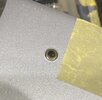My first thought was that it was a stripped Type J battery; however, they are not rechargeable. But looking further they have to be 4 rechargeable cells in series. The 2 AA-type would only give you 2.4V total, not enough to power the electronics. But Rayovac MM724 rechargeable batteries are NiMH based. So the two middle cells must also be NiMH. Very common during the time when DStines produced these tricorders. He could not have used 4 of the AA batteries since it would cause the back panel to bulge when closed. The existing two AA batteries can be pushed to the left and right of the circuit board; then another type of NiMH battery was used like a 9V. However, the battery would still have been too thick so they removed the outer metal jacket of the battery to make it thinner. In the end the whole thing is a mess and would eventually fail.
I would replace the entire power system with a regulated 3.7V 800mAh LiPo battery. It takes up very little room and would power all of the circuitry for several more years. It is also easy to replace when it eventually fails in 8-10 years. I did this with another DStines battery system about 3 years ago and it is still going strong today.

